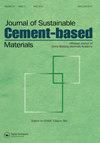高温下碱活性矿渣与粉煤灰掺合海砂混凝土的性能
IF 4.2
3区 工程技术
Q1 CONSTRUCTION & BUILDING TECHNOLOGY
Journal of Sustainable Cement-Based Materials
Pub Date : 2023-10-14
DOI:10.1080/21650373.2023.2266815
引用次数: 1
摘要
摘要粉煤灰-活性矿渣混合海水海砂混凝土(AASC)是一种无需波特兰水泥和河砂的新型混凝土。利用工业废料和海洋资源的优点是既环保又节约成本。本研究旨在探讨AASC在高温下的性能。采用氢氧化钠和水玻璃溶液混合AASC,对矿渣和FA进行活化。进行了加热和压缩试验,分析了AASC的热压缩性能。结果表明,与其他类型的AASC (I型)相比,FA含量较高的AASC (II型)在600℃下具有更少的片状结构和更多的完整界面过渡区;在温度低于400℃时,ⅰ型AASC的力学性能较好,但在温度超过600℃时,ⅱ型AASC的力学性能较差。提出了AASC的压缩本构模型。关键词:碱活性材料;海水;海砂;混凝土;热性能;作者感谢国家自然科学基金(批准号:52178259)和山东省自然科学基金重大项目(批准号:52178259)的支持。ZR2020KA001)、青岛市科技惠民专项(批准号:21-1-4-sf-18-nsh)、青建集团有限公司技术服务项目(批准号:20220149)。本文章由计算机程序翻译,如有差异,请以英文原文为准。
Properties of alkali-activated slag and fly ash blended sea sand concrete exposed to elevated temperature
AbstractAlkali-activated slag and fly ash (FA)-blended seawater sea sand concrete (AASC) is a new type of concrete produced without Portland cement or river sand. The advantages of utilising industrial waste and marine resources are that they are not only eco-friendly but cost-saving. This study aimed to investigate the properties of AASC exposed to elevated temperatures. Slag and FA were activated using NaOH and water glass solutions for mixing AASC. Heating and compressive tests were conducted to analyse the thermal and compressive properties of the AASC. The results showed that the AASC with higher FA content (Type II) had fewer flaky structures and more integral interfacial transition zones than the other type of AASC (Type I) after exposure to 600 °C. Type I AASC had better mechanical performance at temperatures below 400 °C but was inferior to Type II AASC beyond 600 °C. A compressive constitutive model was proposed for AASC.Keywords: alkali-activated materialsseawater sea sand concretethermal propertiescompressive propertieselevated temperature Disclosure statementNo potential conflict of interest was reported by the author(s).Additional informationFundingThe authors gratefully acknowledge the support received from the National Natural Science Foundation of China (Grant No. 52178259), the Major Program of the Natural Science Foundation of Shandong Province (Grant No. ZR2020KA001), Special Project of Science and Technology Benefiting the People of Qingdao (Grant No. 21-1-4-sf-18-nsh), and Technical Service Project by Qingjian Group Co., Ltd. (Grant No. 20220149).
求助全文
通过发布文献求助,成功后即可免费获取论文全文。
去求助
来源期刊
CiteScore
6.60
自引率
15.90%
发文量
71
期刊介绍:
The Journal of Sustainable Cement-Based Materials aims to publish theoretical and applied researches on materials, products and structures that incorporate cement. The journal is a forum for discussion of research on manufacture, hydration and performance of cement-based materials; novel experimental techniques; the latest analytical and modelling methods; the examination and the diagnosis of real cement and concrete structures; and the potential for improved cement-based materials. The journal welcomes original research papers, major reviews, rapid communications and selected conference papers. The Journal of Sustainable Cement-Based Materials covers a wide range of topics within its subject category, including but are not limited to: • raw materials and manufacture of cement • mixing, rheology and hydration • admixtures • structural characteristics and performance of cement-based materials • characterisation techniques and modeling • use of fibre in cement based-materials • degradation and repair of cement-based materials • novel testing techniques and applications • waste management

 求助内容:
求助内容: 应助结果提醒方式:
应助结果提醒方式:


